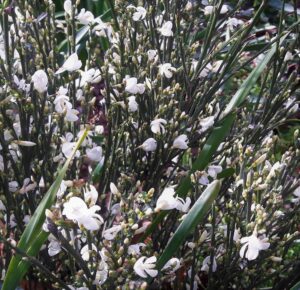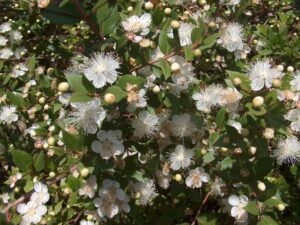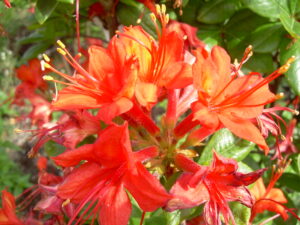Shrubs and trees
Il ne faut pas contrarier les arbres – ‘We mustn’t upset the trees’

The broom is often used by Victor Hugo in his poetry to evoke the idyllic landscapes of Ancient Greece. In the important poem ‘The Satyr’, from La Légende des Siècles I (written in Guernsey, published 1859) a figure not unlike Hugo himself, living quietly on the slopes of Mount Olympus, wanders in a wild and fertile nature, its only inhabitants goats, nymphs and shepherds who co-exist in it without destroying their natural surroundings. In this poem the Satyr, a rebellious and energetic challenger to the gods, becomes one with the landscape.
‘He made free with summer’s splendid charms;
He loved the flower, that naivety;
He nursed with a tender and vast desire
The lily-of the valley, the balmy privet, the broom,
And never did he sleep on duty, even with the poppy;
This libertine was devoted to the rose; …’
In Toilers of the sea, on hero Gilliatt’s last day, as he returns to his stone throne, Hugo describes him wending his way along the coast, for once indifferent to Guernsey’s Arcadian spring: ‘The blackthorn was in flower, the broom was in flower …’. These are both plants that had meaning in Celtic myth; the broom was a plant of healing and creation; the blackthorn, associated with winter, has a sinister reputation in the British Isles, but not elsewhere; despite its dark side, it was seen as representing hope in the midst of devastation. It protected the birds and insects with its thorns. For Hugo, Guernsey was a ‘pays féodal’, an island still feudal, steeped in legend and superstition and redolent of the Middle Ages, but a haven in dark times nevertheless.

‘She endlessly brings forth the flowers that fall,
That never voice complaint to God at all –
From the chaste lilies and ripe vines
And windswept myrtles, not a single cry
Is raised towards the venerable sky
That hears when Innocence pines.’
From ‘Earth: A Hymn’ (‘La Terre, Hymne‘), from La Légende des Siècles *
Myrtus communis, the myrtle, is a native of the Eastern Mediterranean. Guernsey was one of the first places in Britain to grow the myrtle outside as a specimen tree, here in Candie Gardens when they formed the estate of the 18th-century privateer, Pierre Mourant. Mourant was a plant collector, as were many wealthy Guernseymen of the period; they had the connections with overseas, the intellectual curiosity, and the finances to indulge their interests. The myrtle, an evergreen with white flowers, blue-black berries and beautiful bark, was commonly used for weddings, a tradition that began in ancient Greece. It was associated with the goddesses Demeter (or Ceres), and as an aphrodisiac with Aphrodite, who was described as being born from the sea with a sprig of myrtle in her hand. In the classical world, myrtle wreaths represented victory in a bloodless battle and were given to poets and athletes. In Christianity its white flowers symbolised the Virgin Mary. It had been grown since the Middle Ages in Spanish gardens; Victor Hugo may have come across it in Spain as a boy. In Hauteville House garden, a large myrtle shades the stone bench on which Victor Hugo had had engraved a line from Les Contemplations and on which his family and friends were often photographed. Like the broom, the myrtle is used by Victor Hugo to evoke an Arcadian ancient classical world of lyricism and epic. In the follwing extract it is associated by Grantaire, expounding drily in Les Misérables, XII (2), with elements common to the medieval enclosed garden and the classical landscape:
‘Ah! There is no morality of earth. I call to witness the myrtle, the symbol of love, the laurel, the symbol of air, the olive, that ninny, the symbol of peace, the apple-tree which came nearest to strangling Adam with its pips, and the fig-tree, the grandfather of petticoats.’

This rhododendron is an English-bred Knap Hill/Exbury Hybrid, with spectacular scarlet flowers in the spring and brilliant autumn foliage. Raymond Evison chose to plant it in the first section of the garden, announcing its presence from the start, but remaining for the moment in the shade. In the idealised garden of his youth, Les Feuillantines, which this section evokes, Hugo represents himself and his brothers playing near a well in which lived some kind of monster, the ‘sourd’, or ‘deaf one’. In the garden of Hauteville House Hugo replicates this with his own reminder of the evil that existed even in paradise, in the form of a Fountain of Serpents.
Victor Hugo never finished his epic The End of Satan, which he wrote in Guernsey as a companion piece to another long poem entitled God. Hugo explores the nature of evil in The End of Satan, – a title that reflects both meanings of the word – how Satan comes to an end, by finding again God’s grace: ‘Satan is dead – be reborn, celestial Lucifer!’ – and what the purpose of Satan’s existence might be; the human race is also saved through Satan’s own daughter Liberty, who was created from a feather dropped by Satan on his descent in to Hell. Liberty herself goes down into Hell and defeats Satan’s other daughter, the evil Lilith, the Unstoppable Force, Ananke, who was created from darkness, entirely material, soulless. Lilith, of course, had only one fear: of those humans who have sworn to end tyranny, the sons and daughters of the French Revolution.
Victor Hugo greatly admired John Milton, both as a poet and as a person, and here takes ideas from Paradise Lost and Paradise Regained. In his play of 1828 Cromwell, which marks the end of the beginning of Hugo’s move away from supporting the monarchy, Hugo gives John Milton, (who, like Homer, was blind and thus for Hugo, like the seers of old, saw more clearly than sighted poets) stirring speeches and the ability to influence and shame Cromwell while advocating on the side of liberty. (Hugo and his wife had both suffered with eye problems, although Hugo seems to have had excellent eyesight. His complaining about his eyes seems to have coincided with episodes of writer’s block and served as a good excuse to take some time off). Neither Cromwell nor Napoleon Bonaparte, although great heroes of Hugo’s, were able to resist the chance of absolute power; is it possible to be the perfect monarch? Will power always corrupt? Should mankind accept any kind of monarch, even a perfect one whose sole ambition is to do good – or is the perfect prince the answer to many of humanity’s problems? Can such a person even exist? Hugo, who had his own political ambitions, like Cromwell wrestled with these questions. In Hugo’s poem, which is imbued throughout with mysticism, Satan’s story plays out against the background of the battle between the forces of darkness and light for humanity’s freedom. How humanity is to progress in freedom while negotiating the problem of evil, the nature of God, free will, the benevolent dictator, are some of the philosophical conundrums that most occupied the thoughts of the poet.
*’Earth: A hymn’, (‘La Terre: Hymne’), from La Légende des siècles, Transl. E H & A M Blackmore, Selected poems of Victor Hugo, University of Chicago Press, 2004


